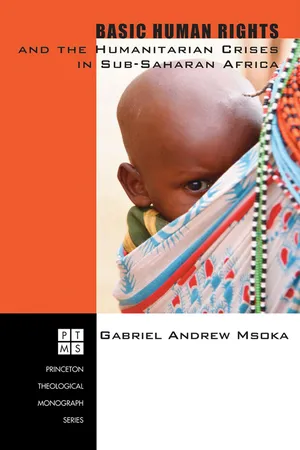![]()
Part I
The Nature and Scope of the Humanitarian Crises
![]()
1
The Root Causes of Refugees and Internally Displaced Persons
Introduction
The crises of mass migrations are a manifestation of the social disorder that has rocked the Great Lakes Region of Sub-Saharan Africa since the 1960’s. This social problem, a consequence reflected in the context of the violence, political and religious conflicts and civil wars, contributes to the humanitarian catastrophes occurring in the area. A comprehensive approach to finding a solution to these crises requires an in-depth understanding of the underlying factors that contribute to the social disorder in this region.
People are deeply divided on the root causes of conflicts and civil wars in Africa, which are a highly contested subject among historians today. Despite differences of opinion, a thorough understanding of the issues leading to conflicts and civil wars is critical to finding effective ways to bring about justice and peace in the region. Ignorance of the root causes of conflicts and civil wars tends to free those responsible for the crises of accountability and obligation to the innocent victims.
In this chapter, I will examine four major combinations of factors that have contributed to the conflicts and civil wars in African countries, and have led to mass exoduses and humanitarian catastrophes in the Great Lakes Region since the 1960’s. The four major combinations of factors are tribalism and colonialism, political leadership and governance, politics and religion, and the Cold War politics and regional conflicts. The social and political situations in Rwanda, the Democratic Republic of Congo (D.R. Congo), Somalia, Uganda, Kenya, and Sudan will be employed as examples to illustrate the factors.
Conflicts and civil wars in these countries have generated refugees, internally displaced persons (IDPs) or both from the 1960’s to this day. Although both groups of displaced people share the similar life condition of homelessness, their legal status varies. According to international refugee law, IDPs are not accorded the same international legal protection as refugees. To clarify the legal distinction between refugees and IDPs, it is extremely important to know the legal definition of each. A historical background of the refugee conventions and the subsequent refugee laws will be discussed.
Terminology
In the aftermath of World War II, the United Nations (UN) recognized the need to address the problems of refugees across Europe. In this context, the UN convened a conference in Geneva, Switzerland, on January 1, 1951, during which “The 1951 United Nations Convention Relating to the Status of Refugees was adopted.” In this convention, the term “refugee” was defined to provide a legal framework for refugees affected by World War II:
Historically, implementing the 1951 UN Convention was limited because it focused only on events that occurred in Europe before January 1, 1951. The operations of agencies such as the United Nations Relief and Rehabilitations Agency (UNRRA), and the International Refugee Organization and subsequently United Nations High Commissioner for Refugees (UNHCR) were limited by a three-year mandate to resettle 1.2 million European refugees left homeless by the global conflict. Over time, as the magnitude of conflicts continued to grow globally, there was a need to address the problems of refugees throughout the world that did not fall under the immediate scope of the 1951 UN Convention. To this effect, the UN General Assembly adopted the “1967 UN Protocol Relating to the Refugee Status,” which expanded its mandate by including events that occurred in Europe, before 1951, and after this period, across the globe. “It is desirable that equal status should be enjoyed by all refugees covered by the definition in the Convention irrespective of the dateline January 1, 1951.”
While the 1951 UN definition of “refugee” is an international landmark for refugee status, it remains substantially unchanged in the face of addressing the current influx of refugees throughout the world. In response to these new realities, the African heads of state and government expanded the definition further by incorporating issues that address the problems of the contemporary Africa. In 1969 the Organization of African Unity (OAU), currently known as the African Union (AU), convened a conference in Addis Ababa, Ethiopia, in the Horn of African Region, during which a Convention that addresses the influx of refugees in Africa was adopted. Hence, “the 1969 OAU Convention Governing the Specific Aspects of Refugee Problems in Africa” is the official regional instrument for protecting refugees in Africa. The 1969 OAU Convention, Article 1, states that the term “refugee”:
While the definition of the OAU reflects the essence of the UN Convention of 1951 and the 1967 UN Protocol Relating to the Status of Refugees, it is also specific to the African situation. The nature of the causes of refugees in Africa is different from that in Europe. In Europe, during the World Wars, inter-state armed conflicts were the major causes of influx of refugees and IDPs. In the early 1960’s, Africa had to cope with the aftermath of the armed struggle of liberation movements, intra-state conflicts, power struggles and external aggression that threatened the newly independent African states. Often these problems led to insecurity, unrest, violence, socio-political instability, and the internal displacement of civilians and refugees. The 1969 OAU Refugee Convention is not opposed to the 1951 UN Convention, but complements the UN Convention definition of “refugee” and the mandate to protect refugees in Africa. In sum, the 1969 OAU Refugee Convention is directed toward implementing the African spirit of communal solidarity among states and governments by protecting civilians who are driven from their homes because of unstable political situations in native states.
The definition of the term “refugee” stipulated in the conventions accords refugee status only to those who have crossed an international border. Therefore, by these definitions, IDPs do not qualify as refugees. However, the difference between refugees and IDPs is simply geographical, namely, the former cross an international border while the latter, for one reason or another, remain in their countries. Although there is a geographical difference betw...
